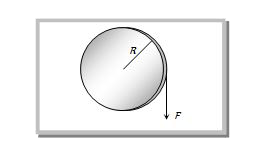A disc of mass 2 kg and diameter 40 cm is free to rotate about an axis passing through its centre and perpendicular to its plane. If a force of 50 N is applied to the disc tangentially Its angular acceleration will be
100rad/s2
25rad/s2
250rad/s2
500rad/s2
The correct Answer is:C
To find the angular acceleration of the disc when a tangential force is applied, we can follow these steps:
Step 1: Identify the given values
- Mass of the disc (m) = 2 kg
- Diameter of the disc = 40 cm, hence the radius (r) = 20 cm = 0.2 m
- Tangential force (F) = 50 N
Step 2: Calculate the moment of inertia (I) of the disc
The moment of inertia (I) for a solid disc rotating about an axis through its center is given by the formula:
I=12mr2
Substituting the values:
I=12×2kg×(0.2m)2
I=12×2×0.04
I=12×0.08
I=0.04kg m2
Step 3: Calculate the torque (τ) applied to the disc
The torque (τ) due to the tangential force is given by:
τ=F×r
Substituting the values:
τ=50N×0.2m
τ=10N m
Step 4: Use the relation between torque and angular acceleration
The relationship between torque, moment of inertia, and angular acceleration (α) is given by:
τ=Iα
Rearranging this to find α:
α=τI
Step 5: Substitute the values to find angular acceleration
Substituting the values of τ and I:
α=10N m0.04kg m2
α=250rad/s2
Conclusion
The angular acceleration of the disc is α=250rad/s2.
---
- Mass of the disc (m) = 2 kg
- Diameter of the disc = 40 cm, hence the radius (r) = 20 cm = 0.2 m
- Tangential force (F) = 50 N
The moment of inertia (I) for a solid disc rotating about an axis through its center is given by the formula:
I=12mr2
I=12×2kg×(0.2m)2
I=12×2×0.04
I=12×0.08
I=0.04kg m2
The torque (τ) due to the tangential force is given by:
τ=F×r
τ=50N×0.2m
τ=10N m
The relationship between torque, moment of inertia, and angular acceleration (α) is given by:
τ=Iα
α=τI
Substituting the values of τ and I:
α=10N m0.04kg m2
α=250rad/s2
The angular acceleration of the disc is α=250rad/s2.
Topper's Solved these Questions
Similar Questions
A disc of radius 0.5m is rotating about an axis passing through its centre and perpendicular to its plane. A tangential force of 2000N is applied to bring the disc to rest 2s. Calculate its abgular momentum.
View SolutionCalculate the moment of inertia of a ring of mass 2 kg and radius 50 cm about an axis passing through its centre and perpendicular to its plane
View Solution
Knowledge Check
Radius of gyration of a uniform circular disc about an axis passing through its centre of gravity and perpendicular to its plane is
AR/√2BR/2C√2 RD2RThe moment of inertia of a copper disc, rotating about an axis passing through its centre and perpendicular to its plane
Aincreases if its temperature is increasedBchanges if its axis of rotation is changedCincreases if its angular velocity is increasedDboth (a) and (b) are correctA disc of radius 10 cm can rotate about an axis passing through its centre and perpendicular to its plane. A force of 10 N is applied along the tangent in the plane of the disc. If the moment of inertia of the disc about its centre is 5kgm2, then the increase in the angular velocity of the disc in 10 s will be
A2 rad/sB4 rad/sC1 rad/sD50 rad/s
A uniform disc of radius R and mass M can rotate on a smooth axis passing through its centre and perpendicular to its plane. A force F is applied on its rim. See fig. What is the tangential acceleration

View SolutionA disc of mass 4 kg and radius 0.2 m, makes 20 rev/s, about an axis passing through its centre and perpendicular to the plane of the disc. The angular momentum of the disc is approximately equal to
View SolutionRadius of gyration of a uniform circular disc about an axis passing through its centre of gravity and perpendicular to its plane is
View SolutionA disc of mass 2 kg and radius 0.2 m is rotating about an axis passing through its centre and perpendicular to its plane with an angular velocity 50 rad/s . Another disc of mass 4 kg and radius 0.1m rotates about an axis passing through its centre and perpendicular to its plane with angular velocity 100 rad/s. If the two disc are coaxially coupled, then the angular velocity of coupled system would be
View SolutionA metallic circular disc having a circular hole at its centre rotates about an axis passing through its centre and perpendicular to its plane. When the disc is heated:
View Solution

